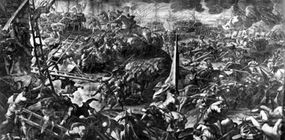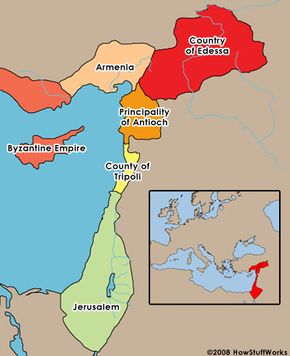Politics in the Crusades
The political impact of the Crusades affected everything from nations' relationships with one another to the creation of entirely new political states. During the First Crusade, Alexius I had asked all crusading generals to swear an oath that any recovered land be returned to the Byzantine Empire. But when Alexius I was discovered retreating from the siege at Antioch, the Crusaders lost respect for the man and were not inclined to fulfill their promises.
As a result, four Crusader States were formed to be ruled by the West: the kingdom of Jerusalem, the principality of Antioch, the county of Edessa, and the county of Tripoli. The new Crusader States lacked strong leadership, however, and they were easily taken back by the Muslims.
Advertisement
In 1144, the Crusader State Edessa was captured, which prompted a call for the Second Crusade (1145-1148). At this point, kings and monarchs from the West began to get involved, which placed a political slant on what transpired during the Second Crusade. When Louis VII of France arrived in Antioch to prepare to take back the Holy Land, he felt the rulers of the Crusader States were undermining the holy purpose of the Crusades. There was some difficulty deciding what city to attack. The armies, meeting at Jerusalem, hesitantly decided to attack Damascus, even though its Muslim emperor was generally friendly with the Crusader States. Damascus was seen as a threat to Jerusalem because of its close proximity. The siege was a failure, however, as we'll see on the next page.
The Second Crusade also laid groundwork for poor political relations between the Byzantine Empire and the West. The Byzantines were none too thrilled about the returning Crusaders, remembering their poor behavior during the First Crusade. The emperor had developed some treaties with the Turks -- a decision that made the West distrust the Byzantines. Louis VII blamed the failure of the Second Crusade on the Byzantines' failure to provide supplies. This feeling unfortunately provided the groundwork for the Fourth Crusade.

The Fourth Crusade (1202-1204) was political from the outset. The armies were to meet in Venice, and then proceed to the Holy Land. However, when the French army arrived, it was much smaller than anticipated, which angered Venice. The French had contracted with Venice for ships and provisions. But the small army didn't need that many supplies, nor could it afford them. The Venetians had already invested a great deal in the French. To get its money's worth, the Venetians ordered that the French take the city of Zadar. The city of Zadar (located in today's Croatia) was a Christian city, but it had been rebelling against Venetian rule. Pope Innocent III strongly disagreed with this strategy, and many knights refused to take part, but Zadar was captured in 1202.
After capturing Zadar, the Crusaders headed toward Constantinople, the capitol of the Byzantine Empire. They planned to take part in a plot to give the throne to a young boy named Alexius Angelus, son of Isaac II, who had been deposed as Byzantine Emperor in 1195. Alexius Angelus promised to help the Crusaders take the Holy Land. Relations had eroded between the East and West, and the Crusaders were eager to win back their ally.
The Crusaders attacked Constantinople, setting fire to a corner of the city, and installed Alexius Angelus as emperor. Alexius Angelus proved to be unpopular and was toppled in another coup. The Crusaders, angry that they hadn't gotten the help they'd been promised, saw this as yet another sign that the Byzantine Empire stood in their way. The Crusaders declared war on Constantinople, and set about looting the richest city in Christendom. They sacked the city for three days, defiling holy places, destroying and stealing valuables, raping women, and cementing the schism between East and West.
Politics played its most successful part in the Sixth Crusade (1228-1229), when Frederick II of Germany managed, through diplomacy and negotiation, to secure Jerusalem for the Christians. This would last for ten years.
Next, we'll learn more about the Crusades' intriguing siege warfare tactics. How were catapults, towers and moats used to attack a walled city? Find out on the next page.
